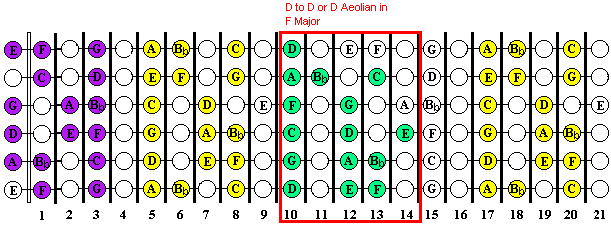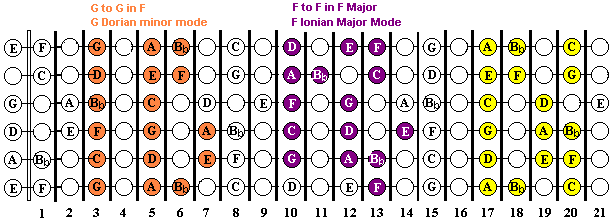 |
A Visual Learning Experience, Lead Guitar Made Easy
Includes Over 150 online guitar lessons - Become better today!
Welcome to Guitar Secrets
Guitar Lessons that work!
[C major modes] [ C Ionian ] [ Dorian mode ] [ Phrygian mode ] [ Lydian mode ] [ Mixolydian Mode ] [ Aeolian mode ] [ Locrian mode ]
[ Basic major scale fingerings ] [ F major modes ] [ G Modes ] [ Constructing Scales ] [ Key Signatures and constructing major scales ] [ Modulation, cadence, progressions ]
Guitar Modes in the key of F major. Learn Guitar Modes
F major modes and lead guitar
It's time to put things together that we've been covering. These examples will use F major and the guitar modes. You should know by now how to construct the major scale and guitar modes. You should also know that there are seven modes in every major key. I have decided to use F major since we have not covered in much or at all in the lessons. I have written this basic rhythm and lead for you to become use to changing modes over each change. It may be hard to hear the rhythm behind the lead, but it will have to do for now. Notice how each lead or scale sounds like it is changes keys. This lead plays only the notes of F major. But if you use the modes properly, it will change the sound over each chord.
The rhythm is out of the key of F major. The notes of F major are F, G, A, Bb, C, D, E and F. The chords in the key of F major are: F, Gm, Am, Bb, C, Dm, E dim and F. I never intend for my songs to be minor oriented, but they seem to end up that way. I like the sound of the Aeolian mode. The sixth note of the major key is the Aeolian mode. It is also the relative minor to the major key it is in. This means the D is the relative or natural minor to F major.
The rhythm being played is a basic rhythm I like to use to come up with ideas. I used the Dm, C, Bb and Dm in that order. I played each as the D5, Bb5, C5 and D5, they each get 8 beats. The lead starts with the D Aeolian scale covering two octaves. This means you play from D to D high E string to the Low E string. Then it uses the F Ionian covering 2 octaves. F to F. Then you use the Dorian Mode which is G to G. The last part of the lead uses arpeggios. The arpeggios are the Dm chord, Bb chord, C chord and then the Dm chord but I think that part got cut off.
This basic lead uses the guitar modes listed below and then incorporates the modes in the lead guitar part.
Basic rhythm and lead in F major using the modes of F major.

The illustration above shows the notes in the key of F major. The red box shows the Aeolian mode D to D in F major. You can also see F Ionian in this box. F to F is the Ionian mode. You can also see the Dm pentatonic notes in the red box. I always try to relate the modes to the pentatonic scales. I know there different, but there also very much alike. The pentatonic scales have only 5 notes and the modes and major keys have 7. But the Dm pentatonic has the notes of the Dm in it. The notes of the Dm are D, A and F. Look at the yellow box to the left. This is the A Phrygian mode which is a minor mode. Remember the notes in the key of F major are: F Gm Am Bb C Dm E dim. You can also see Am pentatonic in this position.
The illustration below now shows the G Dorian scale at the 3rd fret and the F Ionian mode at the 13th fret. Notice that the G Dorian mode is a minor mode and you can see Gm pentatonic in this position. Remember the minor pentatonic root note fret has the fingering 1-4, 1-3, 1-3, 1-3, 1-4, 1-4. Look below and notice that is true for the G 3rd, D 10th and A 17th. Like I said I always relate the modes to the pentatonic scales, either major or minor. I consider the minor modes the minor pentatonic and the major modes the major pentatonic. This may cause some slack, but oh well, that's the way I think. I always try to make things as easy as possible.

How do I see music and making changes? This is not exactly how I would play because I am trying to show you how to do it. I am making things very simple. But here's what's going on. The first chord in the rhythm is the D5 chord. I play the D5 instead of the Dm so I am not limited to playing only over the Dm chord.
So to start things off, I play the Aeolian mode or Dm scale for the D5 chord. The notes of the Dm chord are D, F and A. So the Dm mode will sound good over this chord. I then play the F Ionian mode over the Bb chord. The notes of the Bb chord are Bb, D and F. So I play the F Ionian mode in the Dm position, in purple above. I then play in the G Dorian position over the C5 chord. The notes of the C chord are C, E and G. Look at the orange mode above.
The last part of the lead before the arpeggios are played over the A in yellow in the top illustration 5th fret position. I end it on the A note over the D5. Remember the notes of Dm are D, F and A. The last part of the lead plays directly over each chord of the rhythm. Playing the notes of the Dm, Bb and C.
If this lesson helped you in any way, you should become a guitar secret's member and have access to A Visual Learning Experience, Lead Guitar Made Easy. You will find audio and video examples to help you become a well rounded guitar player. You owe it to yourself, become better today!
Good Luck,
Guitar Secrets
Copyright 1998 - 2019 Guitar Secrets Inc. All rights reserved |